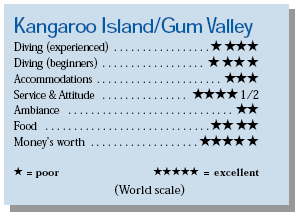Kangaroos and LSDContents of this Issue: Diving From Costa Rica's Mainland TRAVEL TIP— FIJI & NEW ZEALAND Editorial Office: Ben Davison Publisher and Editor Undercurrent 3020 Bridgeway, Suite 102 Sausalito, CA 94965 Looking for leafy sea dragons in Australia from the October, 1999 issue of Undercurrent
Dear Fellow Divers: I’d expected some exciting diving, but I hadn’t expect the excitement to start till I got in the water. Instead the adrenaline kicked in a short way down the road to where the boat was moored, a 45-minute route aptly named White Knuckle. Here we were: an ancient army transport bouncing through verdant hills populated with exotic echidnas, glossy black cockatoos, and wedge-tailed eagles, then snaking down a thousand-foot drop along a precipitous dirt track to the shore of South Australia’s Kangaroo Island. The 20-minute run to the sites was much smoother. Soon Jim Thiselton, our guide and the only dive operator on this coast of Kangaroo Island, was dropping anchor at a spot sheltered by the island cliffs, a site drolly named Pissyboy Rock for its nearby blowhole. New Zealand fur seals stretched lazily as they watched us gear up and stride into the cool water. As we began our descent, we wondered if this 58° water really could be Australia? There was no hard coral to form reefs and walls, but the rocky bottom was covered with myriad colorful samples of what’s advertised as the greatest species diversity of algae anywhere. Kangaroo Island also boasts some of the most prolific soft coral, sponges, and gorgonians found in temperate waters. As we dropped down in the cold, clear water, Jim joined us and pointed the way
toward some boulders and crack-riven ledges. I began combing the growth for our
quarry, the nearly mythical leafy sea
dragon, or LSD. We weren’t deep (about 45' with decent vis and a very gentle surge), and, as our minds and eyes became adapted to this new and different environment, we began to really reap the benefits. This little-dived spot is full of fish: 270 species with 80% endemic in South Australia! In some of the deeper cracks, blue devils peered out, looking much like large, angular, cobalt garibaldis so familiar to southern California kelp bed divers. Large lobsters (crays, in “Strine talk”) lurked in crevices. Plastered among the rocks were lovely abalones of two species, and nearby movement translated into Port Jackson shark, a critter somewhat reminiscent of U.S. west coast horn sharks. That was it: California’s coast, the mental disorientation... This was a lot like diving California 30+ years ago: the same water temps, the same density of life. Even some of the species were similar, but here we were, nearly half a world away! We covered territory slowly to take in the crowd of critters. Film didn’t last long, and underwater photographers should spend several dive days here. In fact, Jim’s client list reads like a who’s who of naturalists and famous photoggers, yet you won’t find a homier, friendlier, and less pretentious dive operation anywhere. Several colorful species of leatherjackets showed themselves from time to time, and poison-spined, zebra-striped old wives looked like red-eyed angelfish, escapees from a freshwater aquarium. Ornate and Shaw’s cowfish, Tommys, strongys, harlequins, and bullseyes were mingled among the old wives. On each trip I saw dolphins and seals, including New Zealand fur seals and rare and endangered Australian sealions, although there were few pelagics. Jim’s a true man of the sea who knows these waters intimately and is happy to guide you to whatever denizen you’re looking for. While the LSD is certainly the grail, it’s hardly one that’s hard to find. Jim Thiselton’s Kangaroo Island Diving Safaris (or KIDS!) will guarantee LSD sightings in two days’ diving or give you two more days of boat diving free! Frankly, I doubt he’s ever had to pay off. Jim’s boat is Eazy II, a 26' Cougar Cat (not a catamaran) that legally seats ten, although he will limit it to six. (Jim’s been casting about for a more spacious boat, and it might be in operation the next season.) There are plenty of hot drinks, water, and a seemingly endless supply of “sangers” (Aussie sandwiches) and other “tucker.” The sea mammals, looming cliffs, and critters like white-bellied sea eagles fill the surface intervals between dives. In my drysuit dives were as long as 45 minutes to an hour. Most dives were easy for experienced divers, depths in the 40s and 50s, some chop and light surge, vis up to 50 feet. All diving is along the north shore, protected from the immense rollers steaming in from frigid Antarctica, the next stop south. Computers are strongly encouraged, along with common-sense profiles. The dive day begins at 9 and ends about 3 or 4. That’s long for a two-tank dive, but the wild rides down White Knuckle consume more than their fair share. Though ninety-by-thirty mile Kangaroo Island, located across the Investigator Strait from Adelaide, South Australia, is accessible by modern modes of transportation including a ferry and commuter aircraft, in many ways it’s reminiscent of some of America’s rural west coast in the 1950s, although residents have plenty of modern conveniences like VCRs and microwaves. The sparsely populated, rolling hills are a hodgepodge of wild coast, scenic farmland, eucalyptus forests, and extensive nature reserve. Many critters long extinct on the mainland are abundant on the island, providing tourists the opportunity for worldclass wildlife sightings. There are no fancy multi-story hotels or giant dive resorts on Kangaroo Island. I stayed at the comfortable Gum Valley Retreat, a half-dozen cozy rooms clustered around a central court. Our room was a basic mid-level U.S.-style motel with private bath and big sliding glass door opening out onto the lawn. While there’s no night diving or night clubbing, there are plenty of night game walks and singalongs accompanied by the player piano. Meals are taken in the family atmosphere of the common dining room. The “tucker” isn’t nouvelle cuisine, just excellent home cooking served with personal warmth by your hosts. Our 8 a.m. breakfasts were whole American affairs, cereal, poached eggs, bacon, toast, and coffee. Dinners were hardly plain-Jane, not with menus like tomato soup, mango slices and marron (Jim’s farm-raised, 4 lb.+ freshwater lobster that may well be the best thing I’ve ever eaten), filet of marinated venison, rolls and fresh vegetable dishes, and a terrific apple cheesecake. Kangaroo Island isn’t the Great Barrier Reef, but it was the perfect antidote to a Papua New Guinea trip full of wonderful pelagic and macro diving. For experienced divers looking for a different and unique adventure, this is a short detour on a “down under” PNG, GBR, or Fiji trip, a 3 air-hour junket from PNG I was glad I’d taken. I’ll treasure memories of diving with Jim Thiselton, of sea dragons, blue gropers, and old wives amid the lush underwater gardens of Kangaroo Island. — L. J.
|

I want to get all the stories! Tell me how I can become an Undercurrent Online Member and get online access to all the articles of Undercurrent as well as thousands of first hand reports on dive operations world-wide
| Home | Online Members Area | My Account |
Login
|
Join
|
| Travel Index |
Dive Resort & Liveaboard Reviews
|
Featured Reports
|
Recent
Issues
|
Back Issues
|
|
Dive Gear
Index
|
Health/Safety Index
|
Environment & Misc.
Index
|
Seasonal Planner
|
Blogs
|
Free Articles
|
Book Picks
|
News
|
|
Special Offers
|
RSS
|
FAQ
|
About Us
|
Contact Us
|
Links
|
3020 Bridgeway, Ste 102, Sausalito, Ca 94965
All rights reserved.

 At one time or another most serious divers make a trip to
Australia's Great Barrier Reef or Coral Sea. For those of
you who wouldn't let a little cold water stand between you and some excellent
diving with bizarre creatures, our travel correspondent has found an offbeat
destination that may be just the add-on for that big trip.
At one time or another most serious divers make a trip to
Australia's Great Barrier Reef or Coral Sea. For those of
you who wouldn't let a little cold water stand between you and some excellent
diving with bizarre creatures, our travel correspondent has found an offbeat
destination that may be just the add-on for that big trip. The LSD is up to a foot
long, resembling a seahorse with long
kelp strands growing from his front and
back. It’s so well camouflaged it can
literally disappear when you turn to
wave your buddy in for a glance. Soon,
I’d found my outlandish-looking prize.
Paint a ten-inch-plus striped yellow
male’s belly up with his mauve eggs,
look at all those plume-shaped streamers
billowing behind, and the name LSD will
roll off your tongue as well!
The LSD is up to a foot
long, resembling a seahorse with long
kelp strands growing from his front and
back. It’s so well camouflaged it can
literally disappear when you turn to
wave your buddy in for a glance. Soon,
I’d found my outlandish-looking prize.
Paint a ten-inch-plus striped yellow
male’s belly up with his mauve eggs,
look at all those plume-shaped streamers
billowing behind, and the name LSD will
roll off your tongue as well!  Diver’s Compass: Kangaroo Island Diving Safaris: phone/fax
011 61 8 8559 3225; e-mail
Diver’s Compass: Kangaroo Island Diving Safaris: phone/fax
011 61 8 8559 3225; e-mail 